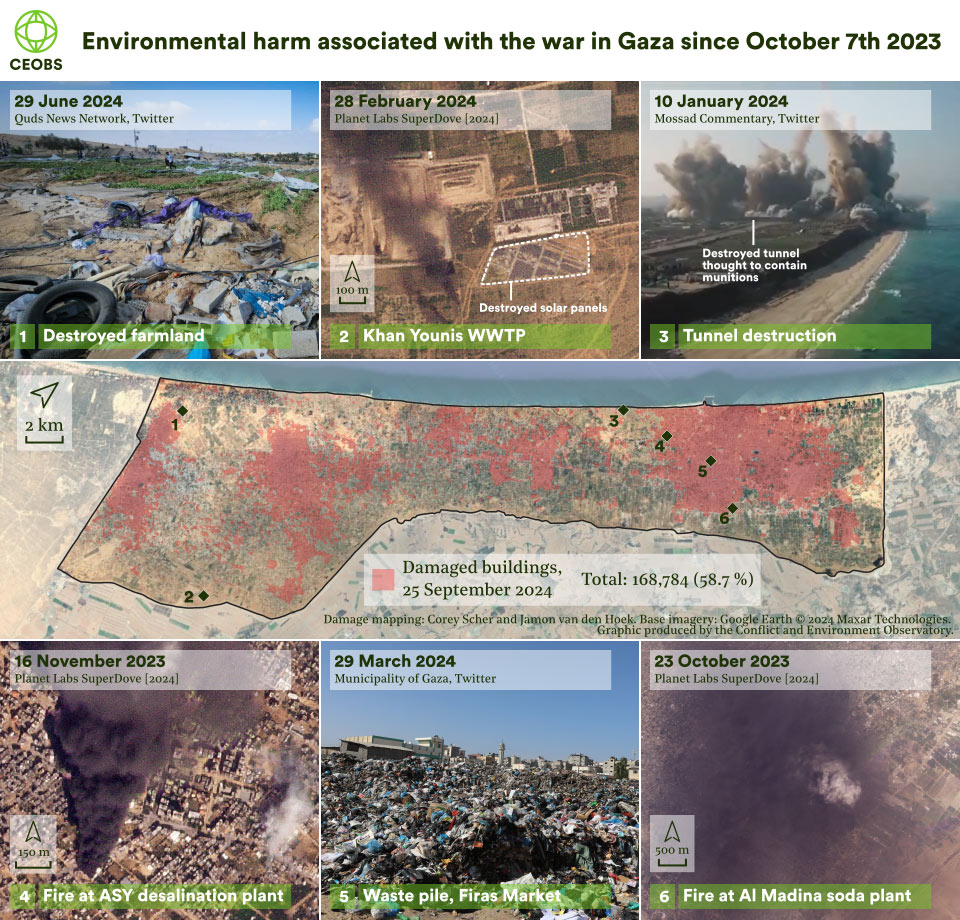By Jonathan Walsh, Rob Watson, Eoghan Darbyshire and Doug Weir, Conflict and Environment Observatory, October 7, 2024
Further escalation in the Middle East will bring further environmental degradation, harming people and ecosystems.
Instability and environmental insecurity
Conflict and insecurity have long been an important driver of environmental degradation in Gaza and the West Bank, Lebanon, Israel and Yemen. Alongside the direct consequences of armed conflicts and military occupation, insecurity has undermined regional environmental cooperation, diverted spending and weakened environmental governance. In the 1980s, the Iran-Iraq war saw the intensive targeting of oil infrastructure and the region witnessed firsthand the environmental consequences of retaliatory attacks against industrial and energy facilities. More recently these have also been a hallmark of the conflicts in Iraq and Syria, which at the time of writing are being dragged deeper into the unfolding crisis.
Across the region, conflict and security-linked environmental degradation is taking place in the shadow of a rapidly changing climate, which is exposing communities to a range of risks, threatening infrastructure and undermining livelihoods. Most exposed to environmental risks are the millions of people who have already been displaced by this latest conflict, and by those that have preceded it. And while it can be difficult to focus on the environment in the face of such profound human suffering, it is vital that we do so because the damage being wrought is threatening human health and eroding the ecosystem services that communities depend on.
Gaza and the West Bank
Fighting in Gaza since October 7th has devastated its environment, destroying livelihoods, natural resources and ecosystems. The intensive use of explosive weapons has generated more than 42 million tonnes of debris and internally displaced nearly 2 million people. This debris, which can be contaminated with asbestos and other polluting building materials, may also contain unexploded ordnance and biological waste. Chronic inhalational exposures to pulverised building materials generated by the use of explosive weapons have been ongoing for months. In addition, domestic solid waste management has collapsed, spawning informal dumpsites that pose health and environmental risks.
Water, sanitation and hygiene (WASH) systems in Gaza are close to complete collapse. Satellite imagery indicates that more than half of Gaza’s water wells, pumping stations, storage tanks and desalination plants have been damaged or destroyed; no desalination plants are now operating.
By October 2024 the Palestinian Water Authority was reporting that more than 85% of Gaza’s water and sewage facilities were either fully or partially non-operational due to extensive damage to critical infrastructure, including to wastewater treatment plants, desalination stations, pumping stations, wells, water tanks and key pipelines. Daily water production had dropped to one third of its pre-war levels due to damage and de-energisation and border restrictions on humanitarian aid was restricting imports from Israel.
This destruction has resulted in discharges of raw sewage into the Mediterranean, and is contributing to an escalating crisis of waterborne disease, particularly among children. Conflict-related contamination of groundwater resources arises from infiltration of surface pollution, as well as the Israeli Defence Force’s (IDF) decision to pump seawater into the tunnel network beneath Gaza. This will further compromise Gaza’s aquifer, already degraded due to decades of over-abstraction, and contribute to worsening water quality and scarcity.
In Gaza, agricultural land and resources have been heavily degraded. By September 2024 UNOSAT and FAO were reporting that 67% of Gaza’s cropland had been damaged; this encompassed 71.2% of orchards and other trees, 67.1% of field crops, and 58.5% of vegetables. Sources of damage include heavy vehicle tracks, deliberate razing and shelling. Gaza’s agricultural infrastructure has also been devastated, with 1,188 agricultural wells (52.5%) and 577.9 hectares of greenhouses (44.3%) damaged.
In the West Bank, settler violence increased in the wake of the October 7th attacks, with rates of land grabbing, the destruction of olive groves and damage or obstruction to water resources at record levels. The loss of agricultural land has implications for food security, livelihoods and identity – and can drive farmers into debt spirals as they are forced to pay for fodder and water. Settler impacts have also extended to West Bank nature reserves, with land lost and habitats disrupted, often with the support of the Israeli authorities. Heightened insecurity has constrained biodiversity monitoring and access to nature.
Remediating the damage to Gaza’s environment will take years, and has environmental implications in itself. Processing the building debris alone will take decades, and one study suggests that up to 80,000 tonnes of CO2 will be emitted from processing only a portion of this debris. It has also been estimated that military activity related to the first 120 days of conflict in Gaza alone created more than 600,000 tonnes of CO2 emissions from bombing and cargo flights, fuel use, and weapons alone; this is almost certainly an underestimate. Reconstruction needs would considerably increase this estimate, potentially adding a further 60 million tonnes of CO2.
Lebanon
After October 7th 2023, Hezbollah’s decision to increase its rocket attacks on Israel led to an intensifying conflict in south Lebanon, with frequent air strikes, artillery use and raids by Israeli special forces; with the fighting displacing both Lebanese and Israelis from border areas. The situation escalated during September 2024 after Israeli attacks intended to weaken Hezbollah’s leadership upended the strategic calculus.
The current political and economic crisis in Lebanon built on years of instability that has undermined environmental governance. The country already faced serious challenges around water and air quality, agricultural productivity, resource management and waste, many of which have been exacerbated by its complicated political system and corruption, as well as by recurring regional crises.
Following October 7th, southern Lebanon’s agricultural land increasingly became a target, even in areas distant from obvious military targets, but important for livelihoods and the production of food and tobacco. Within a week of the Israeli operation in Gaza beginning, explosive and incendiary weapons, including white phosphorus, had burned 5km2 of agricultural land in southern Lebanon. A year on, the burned areas exceeded 114 km2.
As the situation has escalated, Israeli evacuation orders stretching far into southern Lebanon have increased fears that Israel could once again seek to occupy the area, as it did between 1978 and 2000, and during its invasion in 2006. Intensifying airstrikes have been focused on the south, on Beirut and the eastern Beqaa Valley, with toxic white phosphorus again in use. Early impacts include air pollution and the generation of debris from destroyed buildings, as well as further landscape fires. The IDF claims to have targeted and destroyed weapons stores, such attacks can generate toxic remnants of war, while military vehicle movements will damage and degrade soils.
Israel
The October 7th attacks and the ensuing Israeli campaign against Hamas in Gaza have led to direct consequences for Israel’s environment and heavily influenced its domestic environmental governance.
Landscape fires linked to the use of explosive weapons have affected agricultural land and ecologically important areas, predominantly in the regions bordering Lebanon and Gaza. As noted above, Israel’s devastating use of explosive force in Gaza and the destruction of the Strip’s critical WASH infrastructure has exacerbated pre-existing coastal pollution risks from wastewater discharges. The interconnectedness of Gaza and Israel’s environment was made clear with the emergence of polio, and by Israel’s response to it.
Israel’s domestic environmental performance was inadequate even before October 7th, particularly in the fields of waste and climate change – progress on which had been marked by “functional stagnation”. A December 2023 study identified a number of pathways through which the war was impacting Israel’s environment, these included through changes to the energy sector, harm to natural landscapes – through both combat operations and military training – and through weakening environmental governance. Although the Ministry of the Environment received a modest budget increase in 2024 to help address environmental damage linked to the war, the war itself was already undermining environmental regulations. For example, in November 2023, guidance was issued to reduce emissions reporting and energy efficiency requirements in areas affected by the war. The expansion of oil tanker traffic at the Red Sea port in Eilat was justified on security grounds in spite of serious environmental risks.
Israel’s response to the October 7th attacks has also had reverberating consequences for domestic perceptions of the environment and for regional environmental cooperation. It led to the cancellation of a water for energy deal between Israel and Jordan, it has seen Greta Thunburg demonised for expressing solidarity with the Palestinian people, meanwhile opinion writers have weaponised environmental narratives around Gaza. Previously fruitful spaces for environmental cooperation and peacebuilding have shrunk.
Yemen
Houthi opposition to Israel’s war against Hamas in Gaza has drawn the group into the conflict. This has predominantly focused on attacks on Red Sea shipping that the Houthis have deemed connected to Israel. One of the world’s busiest shipping lanes, the Red Sea supports fragile coral ecosystems, while fringing mangroves support local fisheries and protect coastlines. Oil pollution has long been common, although the threat from the dilapidated FSO SAFER oil terminal moored off the port of Ras Isa, which was only resolved in 2023, exemplified the serious risks that conflicts and oil infrastructure can trigger.
While the Houthis ultimately allowed a UN-led salvage operation to mitigate the threat that the SAFER posed, it has not stopped them attacking vessels and creating new environmental threats. This has included sinking the RUBYMAR, which was carrying 21,000 tonnes of ammonium phosphate sulphate fertiliser and heavy fuel oil; and attacks on the CHIOS LION oil tanker, and the SOUNION – which was carrying a million barrels of oil – that seemed intended to trigger an environmental disaster. The vessel was attacked and then boarded, with explosive charges detonated above its tanks. It was subsequently towed to safety by tugs, still ablaze, under an EU naval escort.
Houthi attacks on shipping, and directly against targets in Israel, have seen Israel attack infrastructure in the Yemeni port of Hodeidah – a critical entry point for humanitarian aid. The attacks, which have destroyed fuel storage areas and other environmentally risky facilities, have caused serious pollution events. Houthi military sites have also been targeted by US-led naval forces, and the destruction of weapon caches and launch sites is likely to have generated toxic remnants of war. The displacement of marine traffic on to longer shipping routes has generated significant increases in GHG emissions, less but still notable are those from the military build-up in the Red Sea.
Iran
Iran’s direct attacks on Israel in April and October 2024 have increased the risk that its environmentally sensitive infrastructure will become subject to attacks by Israel. This includes both its economically critical oil infrastructure, as well as facilities linked to its nuclear programme.
Analysts have suggested that the Abadan refinery on the Iraq-Iran border would be a logical target. The refinery accounts for a quarter of Iran’s domestic fuel supply and an attack would mean the Israeli air force would be less exposed to Iranian air defences. However, its proximity to the Shatt-al-Arab river, which marks the border between Iran and Iraq, presents the risk of a significant transboundary pollution incident. Other potential targets include export terminals in the south of the country.
Attacks on Iranian oil facilities – and increased escalation – would increase global oil prices. Such price increases can have complex environmental consequences, these can include temporarily reducing demand and thus emissions, but also driving increased exploration and production, and thus any associated environmental problems.
Iran has a highly developed nuclear weapons programme and is capable of developing nuclear weapons but is yet to do so. Its threshold programme is viewed as a strategic tool to balance against the threat of direct Western military intervention and Israel’s own undeclared nuclear weapons. Following Iran’s attacks on Israel in April, Israel undertook a long-range mission against an air defence system that protects a cluster of Iran’s nuclear facilities around Esfahan.
Direct strikes against nuclear facilities are comparatively rare, and carry with them obvious risks of radioactive releases. Many of Iran’s key facilities are buried and hardened and likely beyond Israel’s capacity to attack en masse. As a result, Israel has historically relied on undermining the programme through targeted assassinations and cyber warfare.
The environmental costs of further escalation
None of the environmental threats that we have outlined above will be improved by further military escalation. Military activities are damaging the region’s ecosystems and creating threats to public health and wellbeing – many of which have the potential to further undermine human security. The region’s environment is fragile, and was already under unsustainable pressure from human activities and the climate crisis. Whether land or water, its future can only be one based on the sustainable and equitable sharing of its resources.
The deteriorating security context is empowering militarised perspectives to the exclusion of environmental considerations, in turn helping to justify further environmental degradation in support of their aims. These perspectives also distort the environmental discourse – such that Israel’s leading expert society for the environment published a story on the IDF reducing single use plastics, even as it rendered Gaza’s environment unliveable.
The staggering destruction in Gaza comes at a time of growing societal sensitisation to the environmental dimensions of armed conflicts. This is encouraging long-overdue intersectional thinking in the climate and peace movements – even as a decade of urgent climate action descends into a decade of conflict. With international talks on biodiversity, the climate crisis and desertification in the coming months, it is imperative that states and other stakeholders reject the temptation to avoid discussing their connections to peace and security. If or when de-escalation comes, long-term attention will be needed to address the environmental consequences of the region’s latest period of conflict, as well as those that preceded it.










